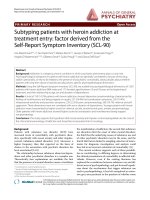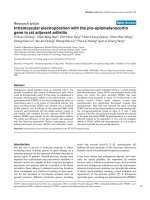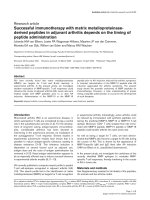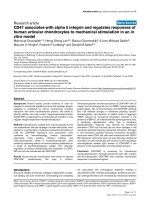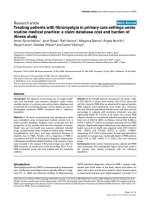Báo cáo y học: "Myocardial ischemia with left ventricular outflow obstruction" ppt
Bạn đang xem bản rút gọn của tài liệu. Xem và tải ngay bản đầy đủ của tài liệu tại đây (670.08 KB, 4 trang )
BioMed Central
Page 1 of 4
(page number not for citation purposes)
Journal of Cardiothoracic Surgery
Open Access
Case report
Myocardial ischemia with left ventricular outflow obstruction
Aron F Popov*
†1
, Christian Bireta
†1
, Jan D Schmitto
1,2
, Dieter Zenker
1
,
Martin Friedrich
1
, Kasim O Coskun
1
, Ralf Seipelt
1
, Gerd G Hanekop
3
and
Friedrich A Schoendube
1
Address:
1
Department of Thoracic and Cardiovascular Surgery, University of Göttingen, Germany,
2
Division of Cardiac Surgery, Department of
Surgery, Brigham and Woman's Hospital, Harvard Medical School Boston, MA, USA and
3
Department of Anaesthesiology, Emergency and
Intensive Care Medicine, University of Göttingen, Germany
Email: Aron F Popov* - ; Christian Bireta - ; Jan D Schmitto - ;
Dieter Zenker - ; Martin Friedrich - ;
Kasim O Coskun - ; Ralf Seipelt - ; Gerd G Hanekop - ;
Friedrich A Schoendube - Schö
* Corresponding author †Equal contributors
Abstract
We report an unusual case of a 32-year old man who was treated for a hypertrophic obstructive
cardiomyopathy (HOCM) with a DDD pacing with short AV delay reduction in the past. Without
prior notice the patient developed ventricular fibrillation and an invasive cardiac diagnostic was
performed, which revealed a myocardial bridging around of the left anterior descending artery
(LAD). We suspected ischemia that could be either related to LAD artery compression or
perfusion abnormalities due to AV delay reduction with related to diastolic dysfunction.
Case report
We are reporting on a 32-year-old patient who had been
treated for a prolonged period of time for symptoms of
HOCM. However, the diagnosis of a flow acceleration and
pressure gradient in the outflow tract had only been made
by echocardiography (ECHO) up to that point. In 2004, a
2-chamber pacemaker with a short AV conduction time
(70 ms) was implanted for a left precordial repolarization
abnormality and to lower the pressure gradient between
the ventricle and outflow tract. Freedom from symptoms
was not actually achieved with this treatment. In February
of this year, the patient was found in a non-responsive
state following what had most likely been a period of
complete well-being. Emergency cardiovascular resuscita-
tion was not started immediatly, however, and the inter-
val before resuscitation was started was approximately 5
minutes. When the emergency medical services arrived,
the patient had no pulse of his own, while the pacemaker
continued to work. After a short period of cardiopulmo-
nary reanimation, a status of ventricular fibrillation was
reached. At this point, a single defibrillation of 200 joules
was applied and spontaneous circulation was established
once again. The patient was only taking inadequate gasp-
ing breaths; as a result, he was intubated immediately. A
low dose of adrenaline was administered due to hypot-
onic circulation; the patient then became hemodynami-
cally stable. Upon admission to our clinic, cerebral
imaging was immediately ordered; this showed no intrac-
erebral bleeding, ischemia or edema. Neuroprotective
hypothermia therapy was also immediately introduced
for a period of 48 hours. Echocardiography revealed
severe left ventricular hypertrophy with normal left ven-
tricular ejection fraction (EF > 60%) and normal dimen-
sions. Additionally, the ECHO exhibited nearly complete
Published: 17 September 2009
Journal of Cardiothoracic Surgery 2009, 4:51 doi:10.1186/1749-8090-4-51
Received: 13 July 2009
Accepted: 17 September 2009
This article is available from: />© 2009 Popov et al; licensee BioMed Central Ltd.
This is an Open Access article distributed under the terms of the Creative Commons Attribution License ( />),
which permits unrestricted use, distribution, and reproduction in any medium, provided the original work is properly cited.
Journal of Cardiothoracic Surgery 2009, 4:51 />Page 2 of 4
(page number not for citation purposes)
obstruction of the the left ventricular outflow tract
(LVOT) by the hypertrophied septum including a systolic
anterior motion phenomena (SAM) by the anterior leaflet
of the mitral valve.
The subsequently performed cardiac catheterization
revealed a non-typical obstruction involving the ventricle
in the ventriculography. There was also a subtotal muscle
bridge of the LAD (Fig. 1) leading to a virtually obstructive
systolic vascular pattern. After stabilizing all parameters,
the patient was finally transferred to our section for a sur-
gical myectomy for HOCM. The LAD was unroofed from
its myocardial bridge (Fig. 2). However, intraoperative
findings surprisingly showed a membranous subaortic
stenosis (Fig. 3) with consecutive left ventricular hypertro-
phy.
The patient survived the operation and his symptoms
were relieved. The postoperative course was uneventful
and postoperative coronary angiogram showed good res-
olution of the muscle bridge in the patient (Fig. 4).
Discussion
HOCM is a complex and heterogeneous disease of cardiac
muscle with a variety of functional, morphologic and clin-
ical manifestations and is associated with various clinical
presentations ranging from complete absence of symp-
toms to sudden, unexpected death. The overall prevalence
of hypertrophic cardiomyopathy (HCM) has been esti-
mated to average between 0.02% and 0.2% of the popula-
tion [1]. The established medical therapy for patients with
HOCM is a trial of large doses of beta-blockers, calcium
channel antagonists, or disopyramide, either alone or in
combination. Operation is a well established procedure
with more than 40 years of experience and has been the
gold standard therapy for those severely symptomatic
patients with fixed or inducible gradients who are intoler-
ant of these medications or unresponsive to them [2-6]. In
addition, alcohol septal ablation, well-accepted as a
potentially curative therapy for HOCM-patients refractory
Preoperative angiogram showing the appearance of the mus-cular bridge over the left anterior descending artery during systoleFigure 1
Preoperative angiogram showing the appearance of
the muscular bridge over the left anterior descend-
ing artery during systole.
Intraoperative view during the reconstruction of LADFigure 2
Intraoperative view during the reconstruction of
LAD.
Excised subaortic membraneFigure 3
Excised subaortic membrane.
Journal of Cardiothoracic Surgery 2009, 4:51 />Page 3 of 4
(page number not for citation purposes)
to maximal medical therapy, is still considered innovative
and becomes widely accepted [7-10].
Additionally, permanent dual-chamber (DDD) pacing
has been proposed as an adjunct treatment to reduce
symptoms in markedly symptomatic patients with
HOCM [11,12]. Several early observational and uncon-
trolled studies have suggested that dual chamber pacing
has a benefit in patients with HOCM. The beneficial
effects were alteration of the myocardial activation
sequence inducing dyssynchronous ventricular activation
and paradoxical septal movement, negative inotropic
effects, and alteration of mitral valve leaflet excursion [13-
15]. However, there are numerous studies of dual cham-
ber pacing that have yielded conflicting results. These
studies have investigated the beneficieal effects of pacing
on gradient, pacing on gradient, symptoms, and quality of
life, but have failed to make a definitive statement con-
cerning the risk of sudden death at the present time.
Finally, it is well known that in patients with HOCM
supraventricular tachycardias are common and several
factors may make these patients susceptible to ventricular
fibrillation [15]. Furthermore, in our case the coronary
angiogram reveals a left anterior descending coronary
artery bridge. Myocardial bridging with compression of
epicardial vessels occurs in 30-50% of adults with HOCM
[16]. The role of myocardial bridging in ischemia and sud-
den death in patients with HOCM remains controversial
[17]. Regardless, a poorer outcome of HOCM combined
with bridging has been outlined [18].
Interestingly, the operation of our patient revealed a sub-
aortic obstruction in the form of subaortic membrane,
which has a congenital basis and is responsible for 8% to
20% of cases of congenital left ventricular outflow
obstruction (LVOT) [19]. In most instances, the lesion
progresses to produce LVOT obstruction during child-
hood and adolescence, while in some instances it does not
[20]. However, there is little information about this lesion
in adults.
Finally, it remains unclear what clinicopathological rea-
sons induced the sudden cardiac death. It is possible, that
the dual chamber pacing with AV delay reduction and/or
the left artery descending bridge induced ischemia which
leads to ventricular fibrillation with cardiopulmonary
resuscitation, otherwise it is also possible that only the
LVOT obstruction lead to ventricular defibrillation. The
benefit of ICD treatment has been been well established
among patients at high risk of sudden cardiac death in sec-
ondary and primary prevention seetings. However, in this
case the myocardial bridging and left ventrucular outflow
obstruction was surgically controlled. Therefore, we
renouced to implantate an ICD.
Thomson et al. have demonstrated the mechanisms of
myocardial ischemia in HOCM-patients with magnetic
resonance imaging (MRI). Possibly, this promising diag-
nostic option becomes routinely available for patients
with HOCM and signs of ischemia.
These patients are a technical challenge and should be
treated by very experienced surgeons, cardiologists, and
anaesthetists in specialized institutions.
Conclusion
On the basis on this case, dual chamber pacing can not
regarded as primary treatment modality for left ventricular
obstruction. For a select subset of patients with refractory
LVOT obstruction, DDD pacing with a short atrioventricu-
lar (AV) delay may be of benefit or represent a therapeutic
option for some elderly patients with HOCM, particularly
those who reject operation/alcohol septal ablation or do
not have access to experienced surgeon and cardiologists
in specialized institutions. However, short delay DDD-
pacing is obviously not acceptable in patients with an
obstructive subaortic membrane.
Consent
Written informed consent was obtained from the patient
for publication of this case report and any accompanying
images. A copy of the written consent is available for
review by the Editor-in-Chief of this journal.
Postoperative angiogram showing patent left anterior descending artery during systole, after incision muscular bridge and reconstructionFigure 4
Postoperative angiogram showing patent left ante-
rior descending artery during systole, after incision
muscular bridge and reconstruction.
Publish with BioMed Central and every
scientist can read your work free of charge
"BioMed Central will be the most significant development for
disseminating the results of biomedical research in our lifetime."
Sir Paul Nurse, Cancer Research UK
Your research papers will be:
available free of charge to the entire biomedical community
peer reviewed and published immediately upon acceptance
cited in PubMed and archived on PubMed Central
yours — you keep the copyright
Submit your manuscript here:
/>BioMedcentral
Journal of Cardiothoracic Surgery 2009, 4:51 />Page 4 of 4
(page number not for citation purposes)
Competing interests
The authors declare that they have no competing interests.
Authors' contributions
AP and FS are members of the surgical team, conceived of
the study, and participated in its design and coordination.
CB, JS, and DZ were involved in the postoperative treat-
ment and were participated in its coordination. RS, MF,
and KC added important comments to the paper and
helped to draft the manuscript. GH was the anaesthetist
involved in theatre and in intensive care unit and helped
to draft the manuscript. FS co-wrote the manuscript. All
authors have read and approved the final manuscript.
Acknowledgements
We gratefully thank Mr. Bernd Stamer (Perfusionist) for taking pictures.
References
1. Wynne J, Braunwald E: The cardioimiyopathies and myocar-
ditides: toxic, chemical, and physical damage to the heart. In
Heart disease: a textbook of cardiovascular medicine 4th edition. Edited
by: Braunwald E. Philadelphia: WB Saunders; 1992:1394-450.
2. Nishimura RA, Giuliani ER, Brandenburg RO, Danielson GK: Myo-
cardial disease: hypertrophic cardiomyopathy. In Mayo Clinic
practice of cardiology 3rd edition. Edited by: Giuliani ER, Gersh BJ,
McGoon MD, Hayes DL, Schaff HV. St Louis: Mosby; 1996:689-711.
3. Maron BJ, McKenna WJ, Danielson GK, Kappenberger LJ, Kuhn HJ,
Seidman CE, et al.: American College of Cardiology/European
Society of Cardiology Clinical Expert Consensus Document
on Hypertrophic Cardiomyopathy: a report of the American
College of Cardiology Foundation Task Force on Clinical
Expert Consensus Documents and the European Society of
Cardiology Committee for Practice Guidelines. J Am Coll Car-
diol 2003, 42:1687-713.
4. Heric B, Lytle BW, Miller DP, Rosenkranz ER, Lever HM, Cosgrove
DM: Surgical management of hypertrophic obstructive cardi-
omyopathy. Early and late results. J Thorac Cardiovasc Surg 1995,
110:195-206.
5. Brunner-La Schonbeck MH, Rocca HP, Vogt PR, Lachat ML, Jenni R,
Hess OM, et al.: Long-term follow-up in hypertrophic obstruc-
tive cardiomyopathy after septal myectomy. Ann Thorac Surg
1998, 65:1207-14.
6. Schoendube FA, Klues HG, Reith S, Flachskampf FA, Hanrath P, Mess-
mer BJ: Long-term clinical and echocardiographic follow-up
after surgical correction of hypertrophic obstructive cardio-
myopathy with extended myectomy and reconstruction of
the subvalvular mitral apparatus. Circulation 1995, 92:122-7.
7. Faber L, Welge D, Fassbender D, Schmidt HK, Horstkotte D, Seg-
gewiss H: One-year follow-up of percutaneous septal ablation
for symptomatic Hypertrophic obstructive cardiomyopathy
in 312 patients: predictors of hemodynamic and clinical
response. Clin Res Cardiol 2007, 96:864-873.
8. Kuhn H, Lawrenz T, Lieder F, Leuner C, Strunk-Mueller C, Obergas-
sel L, Bartelsmeier M, Stellbrink C: Survival after transcoronary
ablation of septal hypertrophy in hypertrophic obstructive
cardiomyopathy (TASH): a 10 year experience. Clin Res Car-
diol 2008, 97:234-243.
9. Seggewiss H, Rigopoulos A, Welge D, Ziemssen P, Faber L: Long-
term follow-up after percutaneous septal ablation in hyper-
trophic obstructive cardiomyopathy. Clin Res Cardiol
2007,
96:856-863.
10. Veselka J, Duchonová R, Páleníckova J, Zemánek D, Tiserová M, Lin-
hartová K, Cervinka P: Impact of ethanol dosing on the long-
term outcome of alcohol septal ablation for obstructive
hypertrophic cardiomyopathy: a single-center prospective,
and randomized study. Circ J 2006, 70:1550-1552.
11. Fananapazir L, Epstein ND, Curiel RV, Panza JA, Tripodi D, McAr-
eavey D: Long-term results of dual-chamber (DDD) pacing in
obstructive hypertrophic cardiomyopathy. Evidence for pro-
gressive symptomatic and hemodynamic improvement and
reduction of left ventricular hypertrophy. Circulation 1994,
90:2731-2742.
12. Maron BJ, Nishimura RA, McKenna WJ, Rakowski H, Josephson ME,
Kieval RS: Assessment of permanent dual-chamber pacing as
a treatment for drug-refractory symptomatic patients with
obstructive hypertrophic cardiomyopathy. A randomized,
double-blind, crossover study (M-PATHY). Circulation 1999,
99(22):2927-33.
13. Pak PH, Maughan WL, Baughman KL, Kieval RS, Kass DA: Mecha-
nism of acute mechanical benefit from VDD pacing in hyper-
trophied heart: similarity of responses in hypertrophic
cardiomyopathy and hypertensive heart disease. Circulation
1998, 98:242-8.
14. Sherrid MV, Pearle G, Gunsburg DZ: Mechanism of benefit of
negative inotropes in obstructive hypertrophic cardiomyop-
athy. Circulation 1998, 97:41-7.
15. Schiavone VA, Maloney JD, Lever HM, Castle LW, Sterba R, Morant
V: Electrophysiologic studies of patients with Hypertrophic
cardiomyopathy presenting with syncope of undetermined
etiology. Pacing Clin Electrophysiol 1986, 9:476-81.
16. Kitazume H, Kramer JR, Krauthamer D, El Tobgi S, Proudfit WL,
Sones FM: Myocardial bridges in obstructive hypertrophic car-
diomyopathy. Am Heart J 1983, 106:131-135.
17. Mohiddin SA, Fananapazir L: Systolic compression of epicardial
coronary and intramural arteries in children with Hyper-
trophic cardiomyopathy. Tex Heart Inst J 2002, 29:290-298.
18. Yetman AT, McCrindle BW, MacDonald C, Freedom RM, Gow R:
Myocardial bridging in children with hypertrophic cardiomy-
opathy - a risk factor for sudden death. N Engl J Med 1998,
339:1201-1209.
19. Sung CS, Price EC, Cooley DA: Discrete subaortic stenosis in
adults. Am J Cardiol 1973, 42:283-90.
20. Bezold LI, Smith EC, Kelly K, Colan SD, Gauvreau K: Development
and validation of an echocardiographic model for predicting
progression of discrete subaortic stenosis in children. Am J
Cardiol 1998, 81:314-20.

